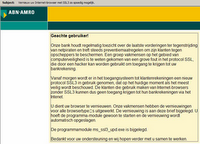Windows Animated Cursor Handling vulnerability could give problems!
What can you do:
Microsoft is reporting that users of Internet Explorer 7 with Protection Mode are protected from active exploitation. E-mails opened in plaintext will not show embedded ANI files. Note that HTML attachments can still be interpreted when separately clicked upon. Anti-virus detection is improving now, with F-Secure, CA, Kaspersky, Trend, Sophos, McAfee and Microsoft detecting malicious ANI files. One specific file was also discovered by a product triggering on a signature written for MS05-002, a similar vulnerability from 2005. This will not apply to most exploits in the wild.
Microsoft has also now confirmed that:
Outlook 2007 users are protected (as the tool uses Word to display HTML messages);
Users of Windows Mail on Vista are protected if they do not forward or reply to malicious e-mail; Outlook Express users remain vulnerable even when reading e-mail as plaintext.
Eeye has released an unofficial patch that you may wish to consider as well .
It was a little bit too quiet these days wasn't it ... well I'm preparing myself something new ... stay tuned! ;-)




